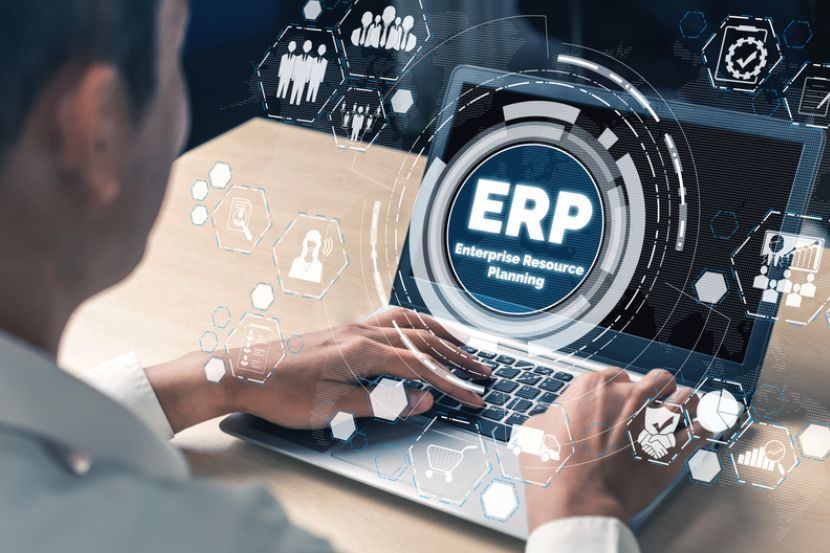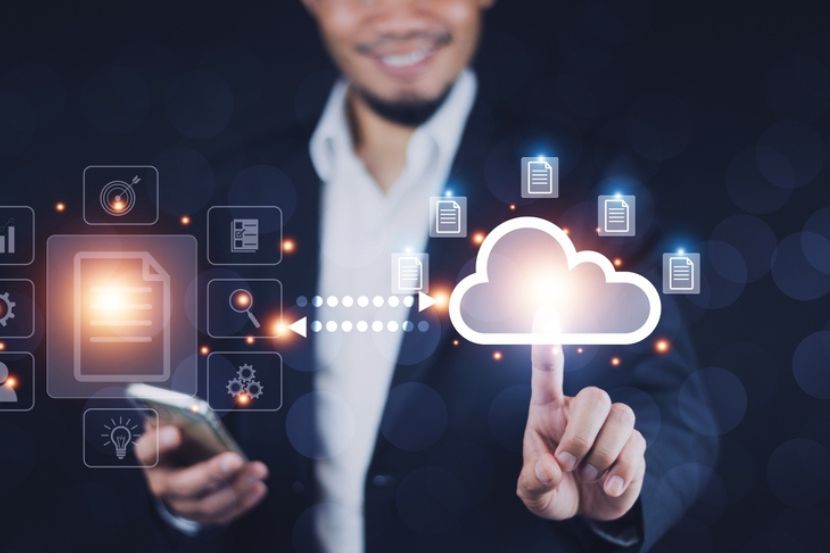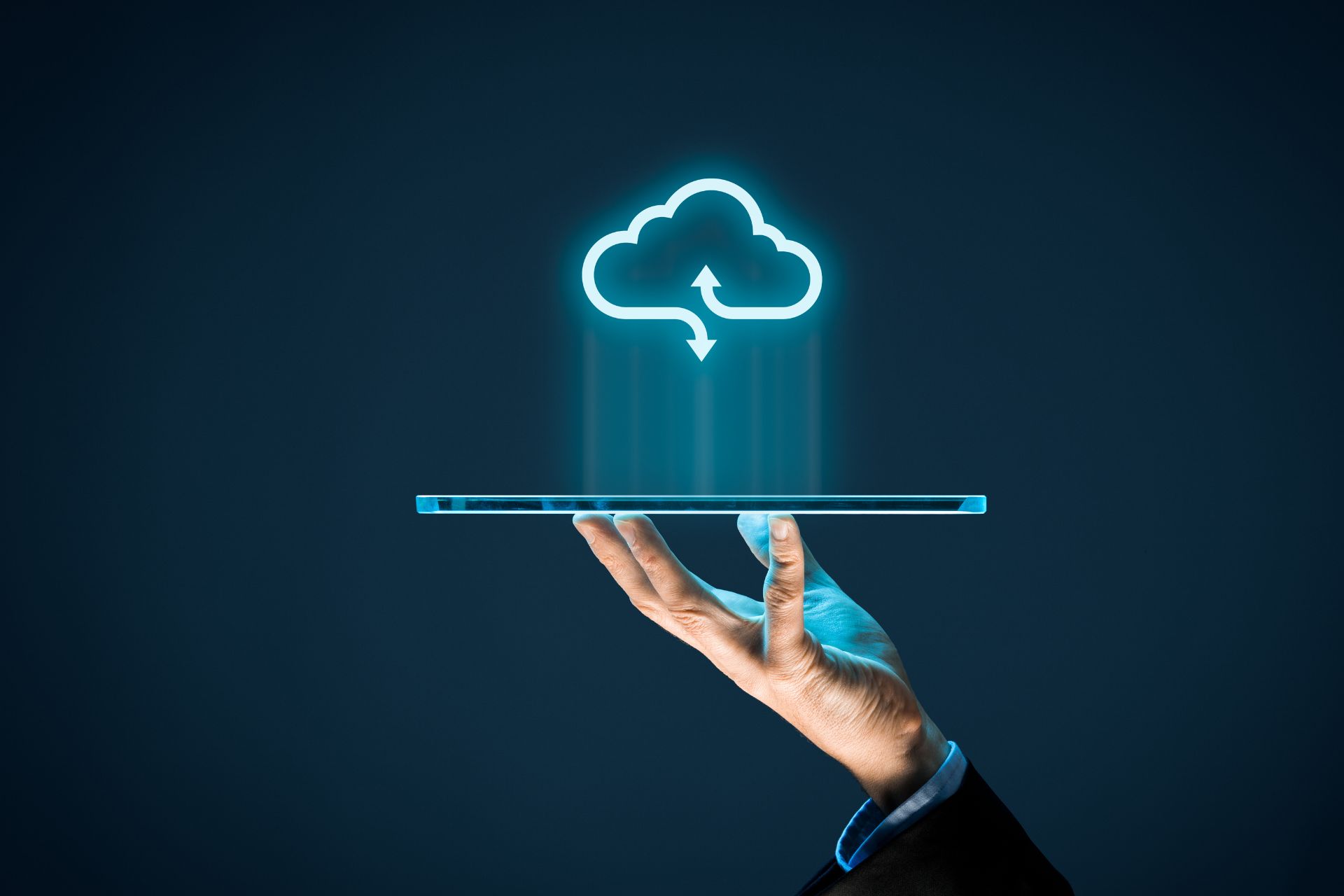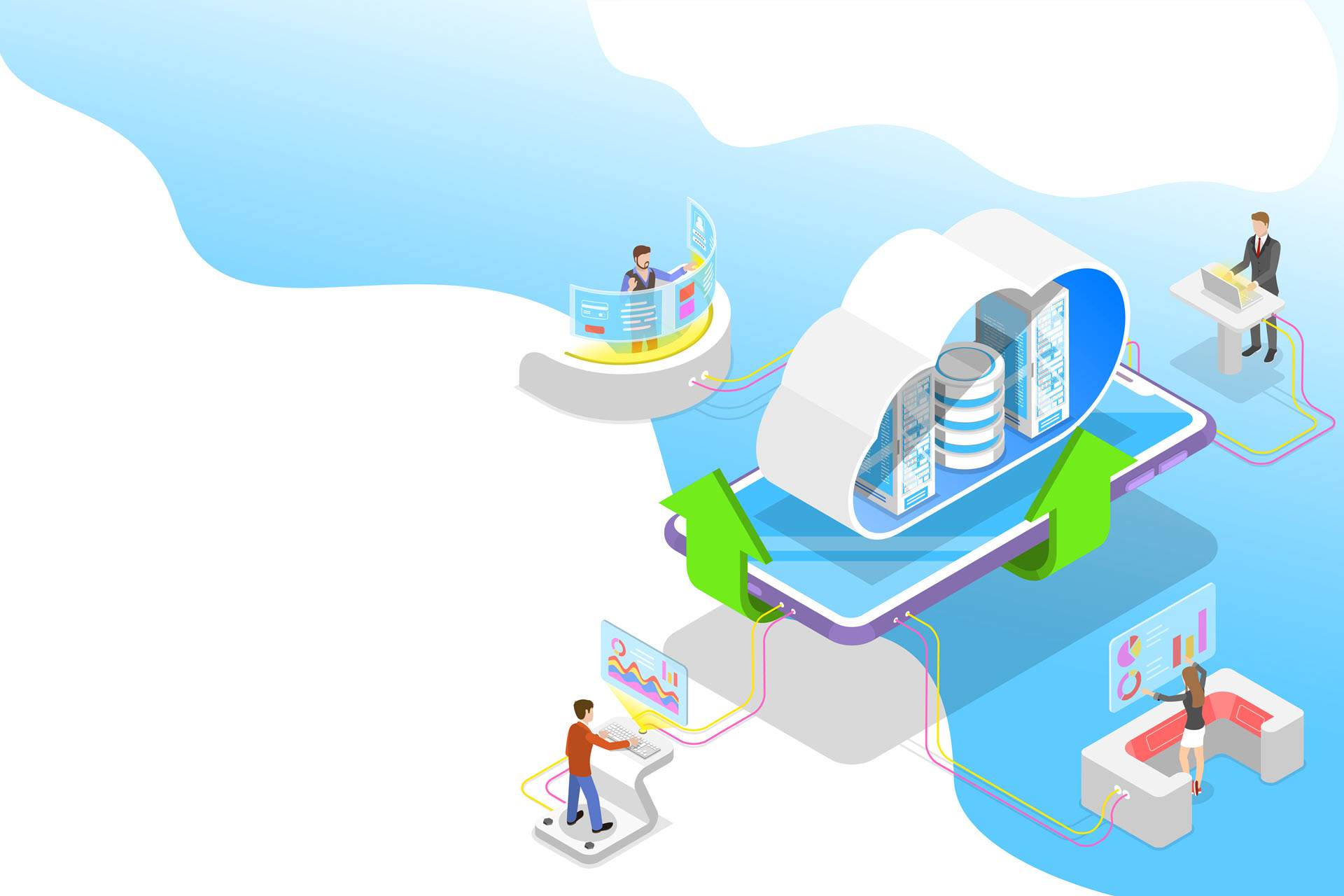As businesses migrate to the cloud, cloud enterprise resource planning systems are becoming increasingly popular. The technology integrates various business processes into a single unified system, leveraging cloud computing to offer a range of benefits over traditional, on-premises solutions. Cloud ERP systems provide a flexible, efficient, and cost-effective way to manage enterprise operations, data, and resources.
This article examines cloud ERP software, exploring the benefits and challenges that await businesses deploying this technology.

What Is Cloud ERP Software?
Cloud ERP (Enterprise Resource Planning) is a cloud-hosted SaaS solution that centralizes and automates a company’s core business processes and resources, such as accounting, human resource management, finance, and supply chain management, into a single integrated system.
When it first appeared, enterprise resource planning software was implemented on-premises, on the organization’s own servers and data centers. However, with the advent of cloud computing, ERP platforms moved to the cloud, where they are now typically delivered as a service.
Cloud ERP Software Components
Cloud ERP software consists of various components or modules that work together to manage different aspects of business operations. Each Cloud ERP solution offers a unique combination of components, depending on the target market and the specific needs of the client.
Cloud ERP software solutions typically provide the following components:
- Financial management. Handles core financial operations such as the general ledger, accounts payable/receivable, budgeting, and asset management. It also provides tools for reporting, compliance, and financial analysis.
- Human resource management (HRM). Manages employee information, payroll, recruitment, training, benefits, performance evaluation, time tracking, etc.
- Customer relationship management (CRM). Manages customer interactions and tracks relevant customer information. It also provides sales management, marketing automation, customer service, and support.
- Supply chain management (SCM). Handles the flow of goods and services, including inventory management, order processing, procurement, and logistics.
- Project management. Assists in the planning, execution, and monitoring of project-related activities, including scheduling, resource allocation, time tracking, and budget management.
- Business intelligence (BI). Features dashboards and data visualization tools that enable businesses to analyze and report on data, thereby aiding strategic decision-making.
- Ecommerce integration. Integrates ecommerce data, including online transactions, customer interactions, and inventory management, with the ERP system.
- Manufacturing and production planning. Handles product planning, materials sourcing, production scheduling, quality control, and cost management.
- Compliance management. Tracks how the business complies with legal and regulatory requirements, provides audit trails, compliance reporting, and risk management.
- Database management. Manages data storage and retrieval, ensuring data integrity, security, and accessibility across all modules of the ERP system.
How Does Cloud ERP Work?
Cloud ERP systems provide a comprehensive suite of applications and tools that businesses access via the cloud, enabling them to manage and integrate vital business functions into a unified system.
As all the data is stored in the cloud and hosted on remote servers, businesses can access it over the Internet. Data is accessible in real-time whenever it is needed and from whichever location, allowing employees to work remotely.
Cloud ERP Software Types
The choice of a Cloud ERP system depends on a variety of factors, including the size of the organization, industry-specific needs, budget restrictions, and the desired functionalities. Before selecting a system, businesses must assess each of these aspects to find the software solution that best meets their operational needs.
Cloud ERP software can be divided into the following types depending on the breadth and scope of functionalities it offers:
Vertical vs. Horizontal Cloud ERP
This division reflects two main approaches to ERP software, differentiated primarily by the target market and the scope of functionalities applicable within the industry.
Vertical ERP is designed with a specific industry in mind and works well with businesses that have well-defined operations. These solutions include features and functionalities that cater to the needs of the industry in question and often come pre-customized, with industry-specific workflows and modules built into them. The downside of these systems is that they often lack flexibility and may not offer broader functionalities.
Horizontal ERP systems are designed to cater to a variety of businesses across industries. They provide a broad range of functionalities that are universally relevant and typically include core business processes such as finance, HRM, and CRM. These solutions are widely applicable and flexible but might require detailed customization to fit the specific needs of the business or industry.
Custom vs. Off-the-Shelf Cloud ERP
Different cloud ERP solutions can also be divided according to the degree of customization and personalization they offer.
Custom ERP systems are built from scratch to meet the specific needs of an individual organization. Highly tailored and with unique features, they align precisely with the particular processes, workflows, and needs of the company. Since they are built from the ground up, they can be scaled or modified as the business evolves, and they can be easily integrated into existing systems. The downside of custom ERP solutions is that they can be time-consuming to set up and costly.
Off-the-shelf ERP systems are prebuilt software packages that cater to the general needs of businesses. They come with standard features, are easy to deploy, and are cost-effective, often through a subscription model. While some customization is possible, it can be limited, so they may include features that are not relevant and may not perfectly fit the needs of the business.
What Cloud ERP Models Exist?
Businesses looking to leverage cloud enterprise resource planning can choose from various cloud deployment models available. The choice depends on various factors, including business size, industry, budget, and desired level of control and customization.
Here are the primary types of Cloud ERP models:
- Public cloud ERP. This model hosts ERP software on public cloud infrastructure provided by third-party CSPs. It is highly scalable and accessible, and also comes at an economical price, as it comes on a subscription basis and doesn’t require a significant upfront investment.
- Private cloud ERP. These ERP solutions are hosted on cloud infrastructure used exclusively by a single organization. Customizable and easy to integrate with other systems, this model offers greater control over data infrastructure and is preferred by businesses with strict security, privacy, and compliance requirements.
- Hybrid cloud ERP. This model combines private and public cloud ERP, allowing businesses to choose where to store their applications. Those applications that require stringent security can be kept on a private cloud, while others can remain on a public cloud, enjoying enhanced flexibility and scalability. The drawback of this model is that managing two types of cloud can introduce complexity and require robust integration and data management strategies.
- Multi-tenant cloud ERP. With this model, multiple businesses share the same ERP infrastructure and software while keeping their data and configuration settings separate and secure. This is a highly cost-effective model but has limited customization options.
- Single-tenant cloud ERP. Each business has its own dedicated instance of the ERP software and infrastructure. This model can be customized and tailored to meet a company’s specific needs but usually comes at a higher cost due to dedicated resources.
Cloud ERP Benefits
Key advantages of cloud ERP solutions include:
- Cost-effectiveness. Cloud ERP typically does not require significant upfront investments, and the subscription-based model spreads the expenses over time, making it affordable, especially for small and medium-sized businesses.
- Accessibility. These systems can be accessed from anywhere with an internet connection, allowing employees to access information on the go and as needed.
- Scalability. Cloud ERP systems are highly scalable, allowing businesses to easily add or remove resources. This is especially beneficial for organizations with fluctuating workloads and startups.
- Real-time data and analytics. Cloud ERP solutions improve efficiency, productivity, and strategic planning by providing real-time insights into business operations.
- Reduced IT overhead. Businesses no longer need to maintain, update, and protect the IT infrastructure necessary for the ERP software.
- Enhanced security and compliance. Providers of cloud ERP solutions invest heavily in security, including data encryption, security audits, and a staff of security experts.
- Disaster recovery and backup. Cloud ERP systems often include disaster recovery and backup capabilities to ensure business continuity in emergencies or after security breaches.
- Automation. Cloud ERP solutions enable the automation of various business processes, including automating tasks such as invoicing, payroll processing, order and inventory management, and report generation.
- Integration. Businesses can seamlessly integrate their cloud ERP systems with other applications and systems, such as external databases, CRM systems, ecommerce platforms, and even IoT devices, so that data flows seamlessly between applications.
- Customization. Cloud ERP providers allow businesses to tailor the software to their specific processes, workflows, and practices.
- Advanced technologies. The integration of artificial intelligence (AI) and machine learning (ML) into ERP systems enables companies to uncover trends, patterns, and valuable insights by analyzing large volumes of data.
- Quick implementation. Cloud ERP solutions can be deployed much faster than traditional on-prem ERP solutions, as the software and infrastructure are already up and running on the cloud.
Cloud ERP Challenges
Before they implement cloud ERP solutions, companies should consider these challenges:
- Data security and privacy concerns. Since data is stored on remote servers managed by the cloud provider, it may pose security and privacy risks to sensitive business data, making it vulnerable to cyber threats or breaches.
- Limited customization and control. Although cloud ERP systems offer some level of customization and control, businesses may still find them lacking compared to on-premises solutions.
- Connectivity issues. Cloud ERP systems rely on internet connectivity, so any issues with internet access, such as low bandwidth and outages, can disrupt business operations.
- Compliance and regulatory challenges. Compliance and regulatory challenges arise from the complexity of handling various regional and industry-specific standards. These issues affect highly regulated sectors or companies that operate in multiple jurisdictions.
- Data migration. Transferring data from one system to a new cloud ERP system can be complex and time-consuming, particularly when the business has large volumes of diverse data stored in multiple systems.
- Integration difficulties. Although providers design ERP systems to integrate easily with other business applications, integrating them with on-premises and legacy systems, as well as cloud-based tools from other vendors, can be challenging.
- Training and change management. Staff need to be adequately trained and prepared to use the new system to ensure successful adoption and use.
- Vendor lock-in. This problem arises when a business becomes overly reliant on a single cloud ERP provider, rendering it costly and complex to switch to an alternative vendor.
Simplify data migration with the right data migration tool.
Cloud ERP Costs
The cost of implementing a cloud ERP system varies greatly depending on several factors, including business size, operational complexity, the specific ERP chosen, and any additional customizations or services required. To make an informed decision, businesses should carefully evaluate their needs, consider all the costs, and request detailed quotes from several ERP vendors.
Here are some of the factors to consider, accompanied by rough estimates of what these services can cost:
- Subscription fees. These are typically billed monthly or annually, depending on factors such as the number of users and the level of functionalities required. They can range from a few hundred to several thousand dollars.
- Implementation costs. Include the expenses associated with the initial setup and configuration of the cloud ERP solution. Fees range from 1.5 to 3 times the annual subscription cost.
- Customization and integration costs. Any additional customizations and integrations beyond the initial setup may incur extra expenses. These vary widely, from a few hundred to several thousand dollars, depending on the extent of the customizations.
- Training and support costs. These services also contribute to the overall costs of a cloud ERP system, depending on the comprehensiveness of the training and support package. Training is usually paid per session, while ongoing support is typically added to the annual subscription cost.
- Data storage costs. Some vendors base their prices on the amount of storage provided. As a business and its storage needs grow, these expenses also rise.
- Exit costs. These are incurred when a business decides to switch to a different cloud ERP system. They include the costs of exporting data and contract termination fees.
Cloud ERP vs. On-Premises ERP: Which is Better?
Companies deciding whether to deploy cloud ERP solutions or invest in an on-premises system should factor in the differences between the benefits and drawbacks of each option. On-premises systems are generally favored by organizations that want to maintain control over their systems and data and have the financial means to invest in infrastructure and in-house IT capabilities. On the other hand, cloud solutions provide scalability, flexibility, and cost-effectiveness, making them suitable for businesses with more limited personnel and financial resources.
For an easy breakdown of the differences between cloud ERP systems and those managed on-premises, consult this table:
| Cloud ERP | On-premises ERP | |
|---|---|---|
| Deployment | Quick; no need to set up a physical infrastructure. | Requires the setting up of a physical infrastructure and an in-house IT team. |
| Cost | Lower up-front costs, paid on a subscription basis. | Higher costs that include licenses, hardware, and infrastructure. |
| Scalability | Easily scalable. | Often more limited and more expensive, as it requires additional hardware/software. |
| Maintenance and upgrades | Managed by the provider. | Handled by the in-house IT team. |
| Security | Managed by the provider; can be a concern due to the data being stored off-premises. | Complete control over security, but requires investment. |
| Customization and integration | Some customization available, but might be limited; easier integration with other cloud services. | Extensive customization options; integrations can be complex. |
| Accessibility | Accessible from anywhere with an internet connection | Limited to the local corporate network and often requires additional configuration, like a VPN, for remote access. |
| Data control | Stored off-site which raises control and compliance concerns | Complete control over data storage |
How to Choose the Right Cloud ERP Software?

To choose the right cloud ERP software for your business, thoroughly assess your needs, focusing on essential processes and future growth plans. Once you have found ERP solutions that provide the necessary functionality and features, make sure they are user-friendly and compatible with your existing systems.
A vital factor to consider is TCO (total cost of ownership), which encompasses not only subscription fees but also other potential hidden costs, including implementation, customization, staff training, and support. The security of your business-critical data is essential, so ensure the ERP system aligns with best cybersecurity practices and relevant regulations. Finally, evaluate the vendor’s reputation, business history, level of customer support available, and the feedback provided by existing users.
Cloud ERP: Steering Your Business to a More Agile Future
Cloud ERP systems are an invaluable tool that stands at the forefront of modern business operations. Like other cloud-based solutions, these systems offer unparalleled flexibility, scalability, and accessibility while providing cost savings. Through real-time insights and enhanced decision-making capabilities, they empower organizations to innovate, grow, and gain a competitive advantage.



